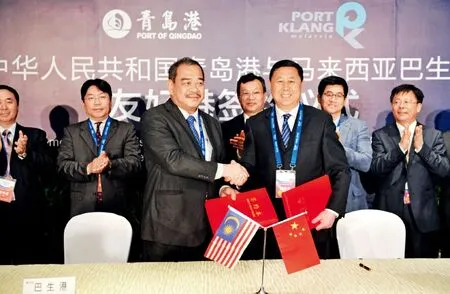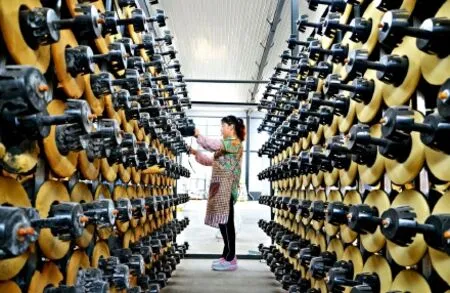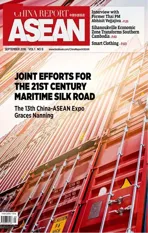Shandong an Engine Powering The Belt and Road Initiative
2016-11-23ByWangZhe
By Wang Zhe
Shandong an Engine Powering The Belt and Road Initiative
By Wang Zhe

On July 25, 2016, the East Asia Seaport Alliance was established in the West Coast New Area of Qingdao, and the port of Qingdao and Port Klang of Malaysia became sister ports.
Embracing the concepts of openness and inclusiveness, Shandong Province in eastern China has assumed a vital role in the Belt and Road Initiative, utilizing its unique geographical and cultural advantages to make itself a globally competitive economic player.
The Belt and Road Initiative,which promotes regional development through a variety of infrastructure projects and cultural exchanges, has seen port cities take on vital roles in economic and cultural exchanges. Shandong,home to several ports, has undergone pilot economic schemes to modernize and succeed under the “new normal” of slower yet healthier Chinese economic growth.
Origins of Development
With a large local population,Shandong has long been considered a cradle of the Chinese civilization. Its historical origins are what enables the province to play such a vital role in the Belt and Road Initiative.
Since the Qin (221-206 BC) and the Han (206 BC-220 AD) dynasties,Shandong has been an important supplier of goods for trade between China and foreign countries. According to historical records, the ancient Maritime Silk Road began at the port of Dengzhou (now Penglai, Shandong), before heading to Ningbo in modern-day Zhejiang Province and Quanzhou in modern-day Fujian Province. Ten, the path continued south toward the Philippines and Australia,before heading north again to Central Asia via the Strait of Malacca.
During the time of the ancient Maritime Silk Road, areas including Qingzhou, Yanzhou (now Jining) and Linzi (now Zibo) were world-renowned handicraft centers in which a large number of exquisite products were made. Such products were sometimes exported via maritime routes but at other times traversed the Ancient Silk Road, traveling west through Kaifeng and Luoyang to Xi'an, cities in modern-day central China. Trade went the other way, too, as businessmen, ambassadors and travelers from Europe,West Asia and Central Asia went east to China, bringing with them their local specialties, customs and artwork.
Even today, many streets famous for silk and porcelain production some 2,000 years ago still remain in Shandong cities, evidencing the huge contribution the Ancient Silk Road made to economic and cultural exchanges between East and West.
Shandong, home to several ports, has undergone pilot economic schemes to modernize and succeed under the “new normal” of slower yet healthier Chinese economic growth.
Today's Advantages
As Shandong integrates into the global economy, its unique advantages related to location, infrastructure, industrial development, openness, technology and culture come into play. Shandong has been able to fully combine itself into the Belt and Road Initiative and carry out swif and effective international cooperation efforts.
Shandong, with the Beijing-Tianjin-Hebei Economic Circle to its north, the Yangtze Economic Zone to its south,the vast Bohai Sea to its east and China's Central Plains to its west, proves itself a strategic pillar along the Eurasian Continental Bridge Economic Corridor and the Maritime Silk Road, according to Wang Zhonglin, director of the Shandong Provincial Development and Reform Commission.
China's extensive rail network has reached each of Shandong's 17 cities, and major highways have reached 96 percent of its counties. The total length of rail tracks within the province has reached 5,350 kilometers, while highways now cover 5,348 kilometers. Goods travelling through its seaports total around 1.3 billion tons per year and there are three ports that each surpass 300 million tons per year — Qingdao, Rizhao and Yantai. The province's nine airports provide more than 300 domestic and international flights daily. With such a three dimensional system of movement of people and goods, Shandong represents a key part of the Belt and Road Initiative in eastern China.
Shandong's economy is comprehensively robust. In 2015, the province's export volume of agricultural products totalled US$15.3 billion, leading the country for 17 years running. Main business revenue reached 14.7 trillion yuan (US$2.2 trillion), ranking first in China. Revenues in the six major industries — light industry, chemicals,mechanical engineering, metallurgy,textiles and electronic communication— exceeded 1 trillion yuan (US$150 billion). The value-added earned from service industries reached 2.85 trillion yuan (US$427 billion), ranking the province third in the country.
Shandong, which has introduced various policies geared toward opening up, has formed economic and trade relationships with more than 220 countries around the world, and developed close relationships with 42 cities in countries along the Belt and Road. In 2015, Shandong invested US$1.1 billion into projects in those countries, representing a year-on-year increase of 78.5 percent.
Currently, there are 166 state enterprises' technology centers and 17 state laboratories in Shandong, more than any other province in China. Shandong has shown particular strength in maritime technology innovation, in large part thanks to its related technological platforms, including the Qingdao National Laboratory for Maritime Science and Technology and the China National Deep Sea Center. Approximately two-thirds of China's maritime science and technology professionals work in Shandong.
In terms of traditional Chinese culture, Shandong has various strengths. It is known as the hometown of both Confucius and Mencius, China's two great ancient philosophers. So far, China has established 500 Confucius Institutes and 1,000 Confucius Classrooms in 134 countries and regions around the world.
Blueprint for the Future
Wang said that in the future,close attention will be paid to policy coordination, facilities connectivity, unimpeded trade, financial integration and people-to-people exchange. Through these areas, Shandong will push forward the Belt and Road Initiative.
Facilities connectivity is the main basis of the Initiative. With an aim to establish an international regional logistics center, Shandong has made international connectivity the focus in its railway,highway and airport development efforts. Freight trains connect Shandong to countries in Central Asia, while direct intercontinental flights connect the province to a variety of areas across the globe.
Te Initiative has also diversified division of labor in Shandong. Companies in the province now engage in six economic corridors that are all part of the Belt and Road Initiative, including the China-Pakistan Economic Corridor,the Bangladesh-China-India-Myanmar Economic Corridor, the China-Russia-Mongolia Economic Corridor, the New Eurasian Continental Bridge Economic Corridor, the China-Central Asia-West Asia Economic Corridor and the China-Indochina Peninsula Economic Corridor.
In the first half of 2016, about 100 Shandong-based firms invested in projects associated with the Belt and Road Initiative, and the revenue of newly signed foreign engineering contracts increased 20 percent compared to the previous year. An increasing number of Shandong companies are now engaged in global cooperation. For example,the Qingdao arm of Wanda Group, a major Chinese conglomerate, recently acquired Legendary Pictures, an American film studio. The Shandong Kingenta Ecological Engineering Company recently acquired Compo, a German fertilizer producer. In the first six months of 2016, the province's overseas investment increased 200 percent,represented by US$3 billion of investment in Pakistan, leading the nation in this regard.
During the past few years of development, Shandong has consolidated traditional trade areas, while also emerging as a global market player in high-end industries such as new materials and new pharmaceuticals. Taking advantage of cross-border e-commerce, outsourcing services and transit trade, the construction of the Sino-German Economic and Technical Cooperation Center, the China-EU Trade and Logistics Park and the Regional Economic Cooperation Demonstration Zone of the China-South Korea Free Trade Area has given Shandong a platform to broaden its investment and trade.
Shandong and countries along the Belt and Road Initiative complement each other in terms of resources such as coal, oil and natural gas. Shandong's production, transportation, processing and services capabilities make extraction, distribution and usage of such resources easier. The China-Pakistan Economic Corridor is an important part of such integration. Until the end of this year, Shandong's contribution to Pakistan's total power generation will account for 15 percent.

A worker at a Shandong factory examining glass candle holders for export.
Financial services, too, are growing quickly in Shandong. The province's banks are providing increasingly diverse types of localized and international financial support for companies and countries involved in the Belt and Road Initiative.
Over the next few years, Shandong will organize events based on the theme of “China's Shandong: the hometown of Confucius”, in an effort to boost tourism and cultural communication. Te province has released the Implementation Plan for Shandong's Participation in Building the Silk Road Economic Belt and 21st-Century Maritime Silk Road,which states that by 2025, the province will establish an international regional logistics center, a foreign cooperation center of the Chinese marine economy,an international cultural cooperation and communication center and a pilot center of interactive development.
Shandong has established the first provincial-level initiative of programs designed to aid the Belt and Road Initiative, with 210 such programs already under way.
“These programs include projects related to infrastructure, energy and resources, production capacity cooperation, cultural communication, financial cooperation, ecological protection and others,” said Qin Ke, deputy director of the Shandong Provincial Development and Reform Commission and deputy managing director of the regional office in Shandong. “Te programs highlight Shandong's advantages in terms of maritime cooperation, its role as a strategically important city and the support of vital construction projects.”
Infrastructure and production capacity projects account for 156 of the 210 programs, with total investment surpassing 450 billion yuan (US$66 billion). On average, the investment in each program is 2.37 billion yuan(US$350 million), and 18 such programs already have investment of more than 5 billion yuan (US$740 million).
